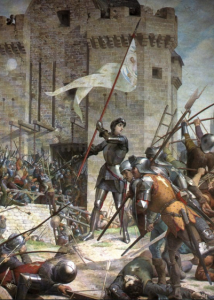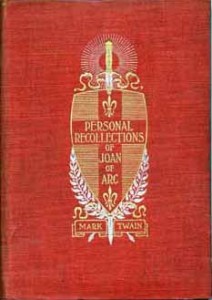In honor of both Women’s History Month and the Cranky Ladies of History project (And to promote their new anthology, Cranky Ladies of History), I present to you my Cranky Lady of History: Saint Joan of Arc (Or Jeanne d’Arc if you don’t like my anglicization of a French name).
Pretty much everyone knows the story of Joan on some level or another. She was taught in the history books I grew up studying, at least. So, I won’t go too much into her other than what the Catholic Church says about her:
 “St. Joan of Arc is the patroness of soldiers and of France. On January 6, 1412, Joan of Arc was born to pious parents of the French peasant class, at the obscure village of Domremy, near the province of Lorraine. At a very early age, she heard voices: those of St. Michael, St. Catherine and St. Margaret.
“St. Joan of Arc is the patroness of soldiers and of France. On January 6, 1412, Joan of Arc was born to pious parents of the French peasant class, at the obscure village of Domremy, near the province of Lorraine. At a very early age, she heard voices: those of St. Michael, St. Catherine and St. Margaret.
At first the messages were personal and general. Then at last came the crowning order. In May, 1428, her voices “of St. Michael, St. Catherine, and St. Margaret” told Joan to go to the King of France and help him reconquer his kingdom. For at that time the English king was after the throne of France, and the Duke of Burgundy, the chief rival of the French king, was siding with him and gobbling up evermore French territory.
After overcoming opposition from churchmen and courtiers, the seventeen year old girl was given a small army with which she raised the siege of Orleans on May 8, 1429. She then enjoyed a series of spectacular military successes, during which the King was able to enter Rheims and be crowned with her at his side.”
I will leave the rest of her history out of it, but the link is here.
 One thing you may not know is that Mark Twain wrote a book about the life of Joan of Arc. It was written in the latter days of his life and became a bit of an obsession for him. Originally it was published in Harper’s Magazine as a serial during 1895, with the book coming out in 1896. At Mark Twain’s request to Harper’s it was published anonymously because he feared it would be taken for a humorous piece, as Mark Twain was known for his satire.
One thing you may not know is that Mark Twain wrote a book about the life of Joan of Arc. It was written in the latter days of his life and became a bit of an obsession for him. Originally it was published in Harper’s Magazine as a serial during 1895, with the book coming out in 1896. At Mark Twain’s request to Harper’s it was published anonymously because he feared it would be taken for a humorous piece, as Mark Twain was known for his satire.
He considered it his best work, and it was arguably the one he spent the most time working on. While his critics disagreed with him I consider it to be one of his best because it is so different from what he was known for. This was a book over 40 years in the making, when he first learned of Joan and became fascinated with her. I sometimes wonder if the eternal skeptic came up against an historical figure whose actions he could not explain in any rational way. Either Joan was completely crazy and was hearing voices, or she was touched by God. If the former, how do you explain her coming to be in command of an entire nation’s army? (All obligatory French jokes aside, the French military was quite powerful at this time. And, failing that, the egos of the nation’s military leaders were even more formidable, making them less likely to bend knee to a peasant girl of 17 years).
Anyway, the book is well worth reading. As is studying the life of Joan herself from non-fiction sources.

